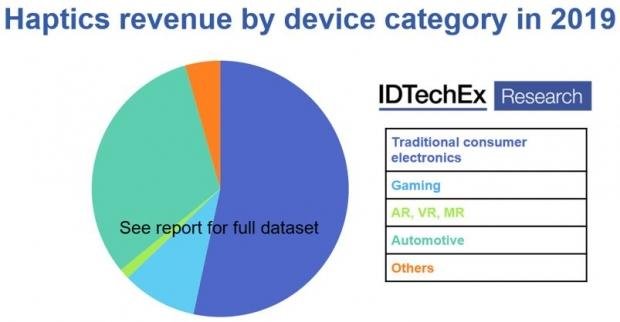BOSTON, September 2, 2019 (Newswire.com) - This is the first of a three-part series of articles on haptics. Haptics involves the use of technology to stimulate the sense of touch. IDTechEx has been covering the technology behind this important market sector for the last five years, and have just released their latest report: Haptics 2020-2030. See more information on the IDTechEx website or contact research@idtechex.com.
The majority of people will experience haptics every day via their smartphone. Haptic feedback includes the vibration when notifications or calls are received, the "clicking" sensation in many phones when interacting with physical buttons, and other touch-based interactions with devices.
However, haptics existed as a prominent technology market well before the smartphone age. Historically, the majority of devices containing haptics were sold in controllers for games consoles. Haptic actuators called ERM motors were deployed to give the familiar vibration feedback at appropriate times during a game.
Haptics in smartphones started using a similar technology. ERM (eccentric rotating mass) motors were deployed in many early smartphones in order to provide vibration feedback corresponding to incoming calls and messages.
Smartphones overtook console gaming as the largest sector for haptics as early as 2011. This is detailed in the extensive historic data (back to 2010) and market forecasts (to 2030) included with the IDTechEx report, "Haptics 2020-2030". IDTechEx have been following the haptics industry for the past 5 years, releasing dedicated reports each year including interviews with key players, market data about haptics technologies, revenues and adoption, and assessment of each of the key technologies involved.
Beyond smartphones, haptics have also been introduced into several other product sectors with varying degrees of success. Devices such as pagers have used haptics for many decades. More recently, the wearable technology sector has widely adopted haptics, particularly in products such as smartwatches and other fitness trackers. Haptics are also used in vehicles, most prominently for driver alerts (e.g. lane departure warnings), but with many companies increasingly looking to add haptic feedback as part of infotainment interfaces in vehicles. Haptics have also been introduced in some laptops (e.g. with actuators under trackpads), albeit with a smaller percentage penetration, and there have even been some attempts to use newer technologies enabling surface haptics in other devices such as tablets.


